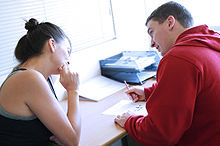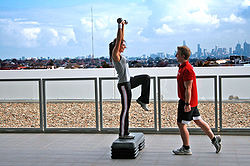- Personal trainer
-
A personal trainer is a fitness professional involved in exercise prescription and instruction. They motivate clients by setting goals and providing feedback and accountability to clients. Trainers also measure their client's strengths and weaknesses with fitness assessments. These fitness assessments may also be performed before and after an exercise program to measure their client's improvements in physical fitness. They may also educate their clients in many other aspects of wellness besides exercise, including general health and nutrition guidelines. Qualified personal trainers recognize their own areas of expertise. If a trainer suspects that one of his or her clients has a medical condition that could prevent the client from safe participation in an exercise program, they must refer the client to the proper health professional for prior clearance. [1] [2]
Contents
Purpose of Personal Training
The scope of practice for a personal trainer is to enhance the components of fitness for the general, healthy population.
Proper exercise prescription may result in improved body composition, physical performance, and health outcomes.[3] The decision to hire a personal trainer may be related to a perceived ability to facilitate these factors through proper prescription and instruction or factors related to motivation and adherence. A personal trainer will pay close attention to your exercise form, workout routine, and nutrition plan.
Few studies have investigated personal training for men. Personal training in women has been shown to exercise behavior patterns, improve perceptual benefit-to-concern ratio for exercise (decisional balance), and increase confidence to choose exercise in the face of other time demands (scheduling self-efficacy).[4] Personal training results in higher strength, higher workout intensities, and higher perceived exertion during exercise in women. Although women working with personal trainers do self-select heavier loads than women who did not, the loads used are still below recommended training load percentages.[5]
Employment Characteristics
The profession is generally not restricted by venue, and personal trainers may work in fitness facilities, in their personal homes, in client homes, or outdoors. Almost all personal trainers and group exercise instructors work in physical fitness facilities, health clubs, and fitness centers located in the amusement and recreation industry or in civic and social organizations.[6]
Personal trainers may specialize in a certain training type, training philosophy, performance type, exercise modality, or client population. In general, most personal trainers develop exercise prescription plans for aerobic exercise, resistance exercise, and/or flexibility training. With aerobic exercise prescription, personal trainers determine the type of exercise, duration of exercise, and frequency of exercise. For resistance exercise prescription, the type of exercise, total session volume, rest period, frequency, and intensity are determined.[7] Personal trainers may also be involved in prescription of stretching routines or other approaches. While some discuss nutrition, ergogenic supplementation, and spiritual practices with clients, there is debate within the industry as to whether it fits within their scope of practice and training qualifications.
Accreditation
Main article: Personal trainer accreditationPersonal trainer accreditation is a process by which certification of competency as a personal trainer may be obtained. Qualification standards for personal trainers vary between countries.
United States of America
A number of certifications are available in United States of America, although a number are not accredited. Most require a high school diploma, cardiopulmonary resuscitation (CPR) and automated external defibrillator (AED) certification, and some type of examination.[6]
A 2002 investigation evaluated a random sample of 115 personal trainers using the Fitness Instructors Knowledge Assessment (FIKA) (which measures knowledge in nutrition, health screening, testing protocols, exercise prescription, and special populations). The study described that:[8][9]
- 70% of those surveyed did not have a degree in any field related to exercise science.
- Those who did not have a bachelor's degree in exercise science-related field scored 31% less than those with a bachelor’s degree or higher in the field.
- Those holding one of two certifications (the American College of Sports Medicine (ACSM) or the National Strength and Conditioning Association (NSCA)) certification scored 83% of the questions correctly.
- Those holding any other certification (other than ACSM or NSCA) answered 38% of the questions correctly.
- Years of experience was not predictive of personal trainer knowledge.
In partnership with the fitness industry, the International Health, Racquet & Sportsclub Association (IHRSA) (which represents over 9,000 health and fitness facilities) started an initiative in 2002 to improve standards for both its own clubs and the industry as a whole. In January 2006, IHRSA implemented a recommendation that its facilities only accept personal trainers with certifications recognized by the National Commission for Certifying Agencies (NCCA) or an equivalent organization. IHRSA considers other accreditation agencies if recognized either by the Council for Higher Education Accreditation (CHEA) and/or the U.S. Department of Education (USED). As of January 2010, ACSM and NSCA certifications are among the 15 accredited certifications recognized by IHRSA, two of which are accredited by an agency other than NCCA (the Distance Education Training Council (DETC)).[10]
There remains no national legal restriction on the industry to date.
Accreditation in Australia
In Australia, personal trainers are required to be a member of a registering body (Fitness Australia or Kinnect) to gain insurance and work as a personal trainer. The minimum qualification is a 'Certificate IV' in Fitness, and they are also required to complete short courses to obtain CEC points which will allow them to keep their registration. A minimum of 20 CEC points per year is required. Many personal trainers also have additional qualifications in weight loss, strength training, kid's fitness, and nutrition
Accreditation in Canada
In Canada, personal training certification differs by province. Some provinces are more stringent on regulation, like British Columbia, where BCRPA (British Columbia Recreation and Parks Association) controls all certifications. Other provinces, like Alberta, are less regulated. In Ontario, the only hands-on personal training school is the National Personal Training Institute (NPTI).
Accreditation in England
In England, there are several ways to achieve a personal training qualification which are achievable through various awarding bodies.
These awarding bodies allow individuals to achieve what is known as a Level 3 personal training qualifications (levels vary from 1 - 5, 1 being basic GCSE level and 5 being advanced specialized training professionals), this Level 3 qualification can then be taken forward to register with REPS (Register of exercise professionals) which is a government backed charity that regulates all fitness professionals and requires those that are registered to do gain CPD points (continual professional development) so that knowledge is kept up-to-date with latest research etc 20 points must be achieved each year an can be done so through courses and workshops. REPS also provides registered fitness professionals with Insurance.
References
- ^ Earle, Roger (2004). NSCA's Essentials of Personal Training. NSCA Certification Commission. pp. 162, 617. ISBN 0-7360-0015-1.
- ^ "NSCA Certification: About the NSCA-CPT credential". National Strength and Conditioning Association. http://www.nsca-cc.org/nsca-cpt/about.html. Retrieved 19 May 2011.
- ^ Kraemer, WJ. Exercise Physiology: Integrating Theory and Application. Lippincott Williams & Wilkins. Ahead of print, March 2011.
- ^ Fischer DV, Bryant J. Effect of certified personal trainer services on stage of exercise behavior and exercise mediators in female college students. J Am Coll Health. 2008 Jan-Feb;56(4):369-76. PMID: 18316279.
- ^ Ratamess NA, Faigenbaum AD, Hoffman JR, Kang J. Self-selected resistance training intensity in healthy women: the influence of a personal trainer. J Strength Cond Res. 2008 Jan;22(1):103-11. PMID: 18296962.
- ^ a b http://www.bls.gov/oco/ocos296.htm
- ^ Kraemer, WJ. Exercise Physiology: Integrating Theory and Application. Lippincott Williams & Wilkins. Chapter 12. Ahead of print, March 2011.
- ^ Malek MH, Nalbone DP, Berger DE, Coburn JW. Importance of health science education for personal fitness trainers. J Strength Cond Res. 2002 Feb;16(1):19-24.
- ^ Moh H. Malek, PhD, CSCS,*D and Tamara K. Coburn. The Level of Exercise Science Knowledge Among Personal Fitness Trainers: A Guideline. [1].
- ^ http://www.ihrsa.org/home/2010/1/14/accreditation-announcement-to-ihrsa-members.html
Categories:- Training
- Sports coaches
Wikimedia Foundation. 2010.



